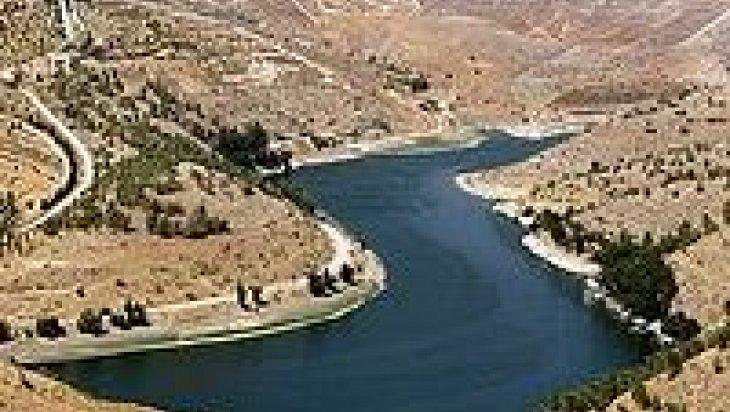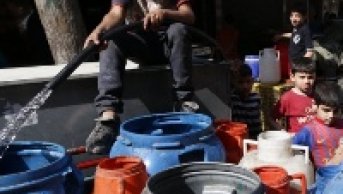Water Scarcity and Its Impacts in Jordan

In regions where arid and semi-arid climate prevails, due to a lack of precipitation and an insufficient amount of surface water resources such as rivers and lakes, water is provided through the overexploitation of groundwater resources. Uncontrolled use of groundwater resources leads to major declines of groundwater levels, saltwater intrusion, the degradation of water quality, and even the drying of wells. Besides, increased sinkholes and landslides, which have been observed around the Dead Sea, stem from the uncontrolled use of the previously mentioned resources.
This year (2014), the Middle East endured its driest winter since the 1970s. The drought has caused a decline in river water levels and has had negative impacts on agriculture, especially in Jordan, Lebanon, Turkey, Iraq, and Syria. Groundwater resources have been exploited to a great extent during this period.
Jordan's estimated total internal renewable water resources are around 682 million m3/year. Its total internal renewable groundwater resources have been estimated around 450 million m3/year. Jordan's main source of water is groundwater resources. In addition, non-renewable water resources and groundwater resources, also known as fossil water, are listed among Jordan's water budget. Based on sustainable yield, estimated renewable groundwater resources are around 275 million m3/year. Overexploitation of groundwater resources have further increased over the last few years and the amount of water withdrawal has reached 200 million m3/year. The safe yield has increased from 135 percent to 225 percent due to the withdrawal of groundwater resources in 7 basins. Excessive abstraction of groundwater is mainly observed in Azraq, which used to supply water to northern region, and whose wetlands dried out in the 1990s.
As is known, Jordan is considered as one of the four most water scarce countries in the world. Developing many projects to fight against the water shortage for years, Jordan has launched the Disi Water Conveyance Project from the Disi aquifer to the capital Amman and other provinces in 2013. Population growth, agriculture, and climate increase the pressure on available water resources in the country. The impact of population growth on water resources has been further exacerbated by forced immigration that was caused by the Syrian civil war since 2011. The official figures indicate that currently 607 thousand Syrian refugees live in Jordan. In northern parts of the country, where refugee camps are located, daily per capita water consumption has dropped from 88 to 66 liters since the influx of Syrian refugees in 2011. Furthermore, in 2014, the Middle East endured its driest winter of the last five decades. While the total rainfall in Jordan during 2014 has been 1/3 of the country's long-term average annual precipitation, the country's dams held only 43 percent of their total capacity before summer 2014. More wells have been drilled to abstract water to meet the water need.
The development of the agriculture sector in Jordan dates back to the 1970s, and currently 70 percent of the groundwater resources in the country is been used for agricultural production. The heavy use of pesticides and animal fertilizer is deteriorating the quality of already limited water resources.
While the aforementioned Disi aquifer provides annually 125 million m3 of water for 50 years, the Jafer Basin's annual safe yield is 18 million m3. The total safe yield of fossil groundwater is 143 million m3/year for 50 years. The Disi Water Conveyance Project will provide the capital Amman and other governorates with 100 million cubic meters of high quality water every year through a 325-kilometer-long steel pipeline for some 25 years. When the project was being planned, there was neither a Syrian civil war nor an influx of Syrian refugees in Jordan. Based on the field research conducted in Jordan, officials estimate that the Disi aquifer will provide shorter-term benefits due to Jordan's high population growth.
The overexploitation of groundwater resources, might create challenges for Jordan to overcome its water shortage in the upcoming period. The Water Authority of Jordan (WAJ) decided to increase the capacity of the Al Qatraneh wells, which are located in Karak Governorate, 140 km south of the capital Amman, to overcome the drought in the short term. In addition, WAJ started drilling a new well in Hassa in the Tafileh Governorate, while the ministry started pumping water from the Lajjoun wells to address the water shortage in the Karak Governorate.
The biggest problem surrounding the overexploitation of groundwater resources are some 1500 illegal agricultural wells. The wells, which are used without any control, lead to a major decline of groundwater levels.
In conclusion; water scarcity in Jordan, which is considered among the water scarce countries, will become much worse due to both its growing population and the current drought. The water shortage will have negative impacts particularly on the agricultural sector and will directly affect the 15 percent of population depending on that sector. Last year, Jordan's wheat import was at a rate of 97 percent. The import of food products in general, which is at a rate of 90 percent, causes increases in food prices across the country. Depending on other countries for food supply leads to worries in terms of food security. As a solution, the percentage of food production in Jordan might increase through encouraging a food pattern that requires a smaller amount of water and through promoting drip irrigation techniques that reduces water use by 90 percent.
Thus, while Jordan, in the equation of increasing water need and changing climate conditions, needs to employ a water management strategy that aims to save and protect water; it also needs to come up with unconventional alternative water resources (desalination, treating hard water, recycling waste water, and water transfer from other countries and basins).
It is essential to seal or mark illegal agricultural wells that lead to overexploitation and the uncontrolled use of groundwater resources. Moreover, water resources, which are degrading with each passing day and also affect the quality of the soil and agricultural products, must be monitored and pollution must be prevented. In addition, a growing population also leads to pollution. How wastewater is disposed is a major problem, especially around refugee camp sites. The relative authorities in the camps remain insufficient in face of this problem. Treating and disposing domestic wastewater is of great importance in terms of the quality of groundwater. Both technical and legal regulations must be made to address the aforesaid issue.
Although the influx of Syrian refugees started in 2011 and it has been more than four years since then, authorities mentioned that the number of Syrian refugees has not been taken into account in Jordan's water-related projects and projections. The number of refugees and possible migration flows must be taken into consideration for an effective water management and sustainable water use in the future.
It is worrying that the water shortage that is caused by the impact of drought might lead to conflicts between communities and states in the region. Jordan has been taking steps that involve cooperation in the Middle East to fight against the water shortage and drought that prevail in the region, including Jordan and Turkey, during this process.







